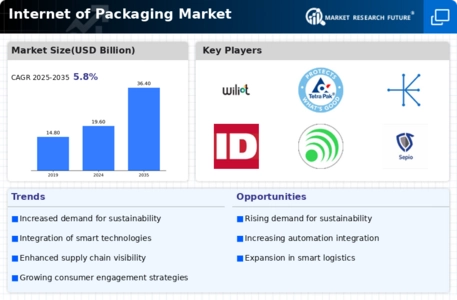Market Analysis
In-depth Analysis of Internet of Packaging Market Industry Landscape
The Internet of Packaging (IoP) has changed the game in packaging, compelling new dynamics within the industry and enhancing the overall supply chain ecosystem at a large scale today. At its heart, IoP merges smart technologies with traditional forms, thereby establishing an entwined collection of appliances that communicate and exchange information throughout any product's entire duration on the earth's surface. A major aspect concerning market dynamics in Iop involves increased consumer engagement /experience approach being adopted by players within the industry. In this case, brands using smart packaging technology fitted with sensors, RFID tags, or QR codes are able to reach out directly to the final consumer. As a result of this, companies can provide live updates, custom content, and even interactive experiences using mobile applications that do not just die out after the point of sale, as such things used to be done. Therefore, consumers are increasingly looking for authentically produced goods or services that are environmentally friendly, and they will stick with brands when they find them. Another driver behind IoP's market dynamics is efficiency gain. This helps in monitoring products across the supply chain since packaging gets integrated with sensors and monitoring devices. This minimizes damage due to theft or loss of items; moreover, it improves distribution processes through effective stock control that ensures optimal positioning of merchandise. Sustainability is another aspect that plays a significant role in IoP's market dynamics. Over the years, there has been considerable focus on environmental conservation at the global level, making packaging solutions come under scrutiny for their ecological impact. For instance, smarter practices like those enabled by IOP could go a long way in addressing these concerns. Companies can apply sensors and data analytics to optimize package design, minimize material usage, and improve recycling techniques, among other ways of boosting efficiency within that particular area. Subsequently, intelligent packaging facilitated by IoT prolongs food expiry dates, thereby reducing waste and supporting sustainability targets. Interconnectivity is one of the features that define the market dynamics of IoP by promoting collaboration among different stakeholders in the packaging ecosystem. In the IoP network, from producers and suppliers to logistics service providers and retailers, information flows have been made seamless. Thus, this interdependence not only promotes communication and cooperation but also results in new sources of value creation through business models and related partnerships. Despite a good outlook, challenges exist within IoP's market dynamics, including data security matters. Moreover, the rise in the generation of data from smart packages necessitates increasing cyber security levels for the secure handling of sensitive information. Furthermore, industry players ought to properly address regulatory environments to ensure compliance with consumer rights protection statutes. This has led experts to stipulate that overcoming these challenges will be vital for sustainable growth and adoption of IoT in Packaging (IoP) within the packaging sector.


 Source: Secondary Research, Primary Research, Market Research Future Database and Analyst Review
Source: Secondary Research, Primary Research, Market Research Future Database and Analyst Review









Leave a Comment